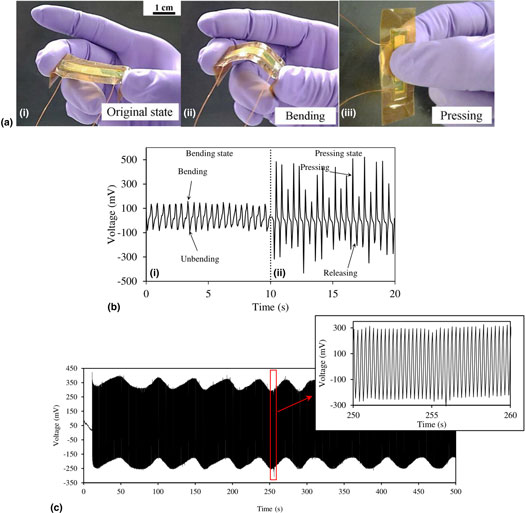Crossref Citations
This article has been cited by the following publications. This list is generated based on data provided by
Crossref.
Garcia Rosales, Carlos A
Garcia Duarte, Mario F
Kim, Hoejin
Chavez, Luis
Hodges, Deidra
Mandal, Paras
Lin, Yirong
and
Tseng, Tzu-Liang (Bill)
2018.
3D printing of shape memory polymer (SMP)/carbon black (CB) nanocomposites with electro-responsive toughness enhancement.
Materials Research Express,
Vol. 5,
Issue. 6,
p.
065704.
Chavez, Luis A
Elicerio, Victor F
Regis, Jaime E
Kim, Hoejin
Garcia Rosales, Carlos A
Love, Norman D
and
Lin, Yirong
2018.
Thermal and mechanical energy harvesting using piezoelectric ceramics.
Materials Research Express,
Vol. 6,
Issue. 2,
p.
025701.
A. Krishnaswamy, Jagdish
Buroni, Federico C.
Garcia-Sanchez, Felipe
Melnik, Roderick
Rodriguez-Tembleque, Luis
and
Saez, Andres
2019.
Lead-free piezocomposites with CNT-modified matrices: Accounting for agglomerations and molecular defects.
Composite Structures,
Vol. 224,
Issue. ,
p.
111033.
Bodkhe, Sampada
and
Ermanni, Paolo
2019.
Challenges in 3D printing of piezoelectric materials.
Multifunctional Materials,
Vol. 2,
Issue. 2,
p.
022001.
Chavez, Luis A.
Regis, Jaime E.
Delfin, Luis C.
Garcia Rosales, Carlos A.
Kim, Hoejin
Love, Norman
Liu, Yingtao
and
Lin, Yirong
2019.
Electrical and mechanical tuning of 3D printed photopolymer–MWCNT nanocomposites through in situ dispersion.
Journal of Applied Polymer Science,
Vol. 136,
Issue. 22,
Shi, Shaohong
Chen, Yinghong
Jing, Jingjing
and
Yang, Lu
2019.
Preparation and 3D-printing of highly conductive polylactic acid/carbon nanotube nanocomposites via local enrichment strategy.
RSC Advances,
Vol. 9,
Issue. 51,
p.
29980.
Kim, Hoejin
Wilburn, Bethany R
Castro, Edison
Garcia Rosales, Carlos A
Chavez, Luis A
Tseng, Tzu-Liang Bill
and
Lin, Yirong
2019.
Multifunctional SENSING using 3D printed CNTs/BaTiO3/PVDF nanocomposites.
Journal of Composite Materials,
Vol. 53,
Issue. 10,
p.
1319.
Krishnaswamy, Jagdish A
Buroni, Federico C
Garcia-Sanchez, Felipe
Melnik, Roderick
Rodriguez-Tembleque, Luis
and
Saez, Andres
2019.
Improving the performance of lead-free piezoelectric composites by using polycrystalline inclusions and tuning the dielectric matrix environment.
Smart Materials and Structures,
Vol. 28,
Issue. 7,
p.
075032.
Kim, Hoejin
Manriquez, Luis Carlos Delfin
Islam, Md Tariqul
Chavez, Luis A.
Regis, Jaime E.
Ahsan, Md Ariful
Noveron, Juan C.
Tseng, Tzu-Liang B.
and
Lin, Yirong
2019.
3D printing of polyvinylidene fluoride/photopolymer resin blends for piezoelectric pressure sensing application using the stereolithography technique.
MRS Communications,
Vol. 9,
Issue. 3,
p.
1115.
Zhou, Xinran
Parida, Kaushik
Halevi, Oded
Magdassi, Shlomo
and
Lee, Pooi See
2020.
All 3D Printed Stretchable Piezoelectric Nanogenerator for Self-Powered Sensor Application.
Sensors,
Vol. 20,
Issue. 23,
p.
6748.
Wu, H.
Fahy, W.P.
Kim, S.
Kim, H.
Zhao, N.
Pilato, L.
Kafi, A.
Bateman, S.
and
Koo, J.H.
2020.
Recent developments in polymers/polymer nanocomposites for additive manufacturing.
Progress in Materials Science,
Vol. 111,
Issue. ,
p.
100638.
Krishnaswamy, Jagdish A
Buroni, Federico C
García-Macías, Enrique
Melnik, Roderick
Rodriguez-Tembleque, Luis
and
Saez, Andres
2020.
Design of lead-free PVDF/CNT/BaTiO3 piezocomposites for sensing and energy harvesting: the role of polycrystallinity, nanoadditives, and anisotropy.
Smart Materials and Structures,
Vol. 29,
Issue. 1,
p.
015021.
Krishnaswamy, Jagdish A
Buroni, Federico C
Melnik, Roderick
Rodriguez-Tembleque, Luis
and
Saez, Andres
2020.
Design of polymeric auxetic matrices for improved mechanical coupling in lead-free piezocomposites.
Smart Materials and Structures,
Vol. 29,
Issue. 5,
p.
054002.
Dul, Sithiprumnea
Fambri, Luca
and
Pegoretti, Alessandro
2020.
Structure and Properties of Additive Manufactured Polymer Components.
p.
17.
Krishnaswamy, Jagdish A.
Buroni, Federico C.
Melnik, Roderick
Rodriguez-Tembleque, Luis
and
Saez, Andres
2020.
Advanced modeling of lead-free piezocomposites: The role of nonlocal and nonlinear effects.
Composite Structures,
Vol. 238,
Issue. ,
p.
111967.
Krishnaswamy, Jagdish A.
Rodriguez-Tembleque, Luis
Melnik, Roderick
Buroni, Federico C.
and
Saez, Andres
2020.
Size dependent electro-elastic enhancement in geometrically anisotropic lead-free piezocomposites.
International Journal of Mechanical Sciences,
Vol. 182,
Issue. ,
p.
105745.
Al Rashid, Ans
Khan, Shoukat Alim
G. Al-Ghamdi, Sami
and
Koç, Muammer
2021.
Additive manufacturing of polymer nanocomposites: Needs and challenges in materials, processes, and applications.
Journal of Materials Research and Technology,
Vol. 14,
Issue. ,
p.
910.
Koroglu, Levent
Ayas, Erhan
and
Ay, Nuran
2021.
3D Printing of Polyvinylidene Fluoride Based Piezoelectric Nanocomposites: An Overview.
Macromolecular Materials and Engineering,
Vol. 306,
Issue. 10,
Zheng, Yufan
Zhang, Wenkang
Baca Lopez, David Moises
and
Ahmad, Rafiq
2021.
Scientometric Analysis and Systematic Review of Multi-Material Additive Manufacturing of Polymers.
Polymers,
Vol. 13,
Issue. 12,
p.
1957.
Krishnaswamy, Jagdish A.
Buroni, Federico C.
Melnik, Roderick
Rodriguez-Tembleque, Luis
and
Saez, Andres
2021.
Multiscale design of nanoengineered matrices for lead-free piezocomposites: Improved performance via controlling auxeticity and anisotropy.
Composite Structures,
Vol. 255,
Issue. ,
p.
112909.




